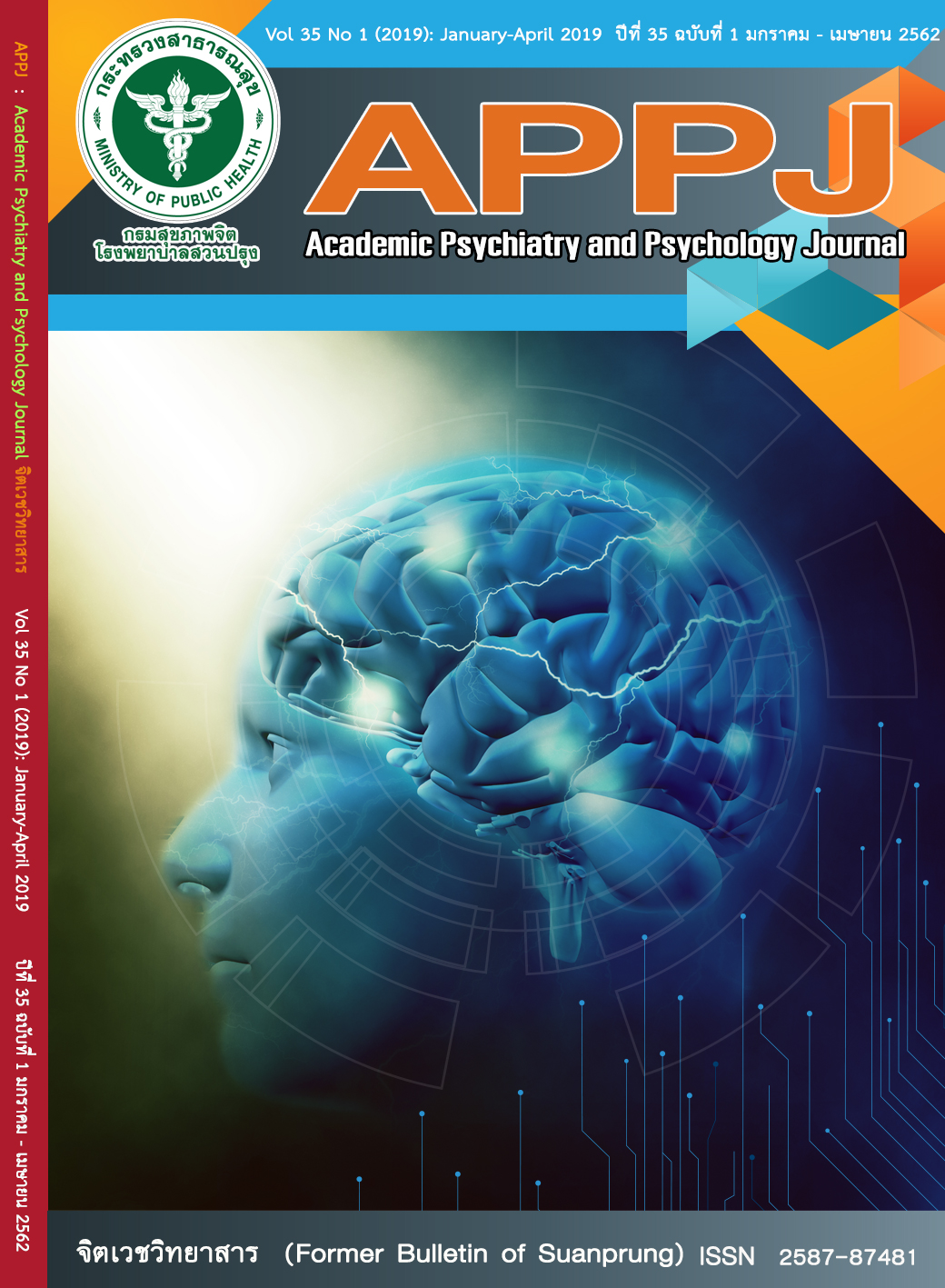Developing Hand Dexterity Test for Children Aged 6 - 12 Years
Main Article Content
Abstract
Objective: The purposes of the study were to develop a hand dexterity test for children and to study its psychometric properties.
Materials and methods: This was a developmental research. Children, aged 6-12 years old, were randomly selected: 180 typical children and 30 delayed development children. Data were collected from 4 schools in Muang, Chiang Mai between March-October 2017. The content validity was examined by 3 experts. The construct validity was verified by testing 180 participants aged 6-12 years, The concurrent validity was verified by examining the score difference between 2 matched pair groups: 30 typical children and 30 children with poor hand dexterity. The interrater reliability was studied between 2 raters. Data analysis used Descriptive statistics, One-Way ANOVA, Paired t test, and Pearson Correlation.
Results: The Children Hand Dexterity Test was developed using a holed board size 9”x 19” and 15 pegs. There were 4 test items: placing pegs with one hand, placing pegs with two hands, hand manipulation and tool use (tongs). The content validity was good. The index of congruence was 1. The CHDT had good construct validity, showing hand dexterity development corresponding to age increment. The CHDT had good concurrent validity, showing significant score difference between typical children and children with poor hand dexterity (p < .05). The interrater reliability was high (r = 0.96).
Conclusion: The CHDT had reliability as well as validity and could be used to measure hand dexterity for children aged 6- 12 years old
Key words: Test, Dexterity, Hand, 6-12 years old
การพัฒนาแบบทดสอบความคล่องแคล่วในการทำงานของมือสำหรับเด็กอายุ 6-12 ปี
บทคัดย่อ
วัตถุประสงค์: เพื่อพัฒนาแบบทดสอบความคล่องแคล่วในการทำงานของมือสำหรับเด็ก อายุ 6-12 ปี และศึกษาคุณสมบัติการวัดของแบบทดสอบฯ
วัสดุและวิธีการ: การศึกษานี้เป็นการวิจัยเชิงพัฒนา สุ่มกลุ่มตัวอย่างอายุ 6-12 ปี เด็กปกติ 180 คน เด็กพัฒนาการช้า 30 คน เก็บข้อมูลจาก 4 โรงเรียนในเขตเมือง จ. เชียงใหม่ ศึกษาระหว่างมีนาคม-ตุลาคม 2560 1) ความเที่ยงตรงเชิงเนื้อหา พิจารณาโดยผู้เชี่ยวชาญ 3 ท่าน 2) ความเที่ยงตรงเชิงโครงสร้าง ศึกษาในกลุ่มเด็ก 180 คน 3) ความเที่ยงตรงเชิงสภาพ ศึกษาในกลุ่มเด็กปกติและเด็กพัฒนาการช้า กลุ่มละ 30 คน และ 4) ความเชื่อมั่นระหว่างผู้ทดสอบ 2 คน การวิเคราะห์ข้อมูลใช้สถิติเชิงบรรยายและOne Way ANOVA, Paired t test และ Pearson Correlation
ผล: แบบทดสอบฯ ที่พัฒนาขึ้นเป็นกระดานเจาะรู ขนาด 9”x 19” จำนวน 1 แผ่น และหมุด 15 ตัว มี 4 การทดสอบคือ (1) การย้ายหมุดโดยใช้มือเดียว (2) การย้ายหมุดโดยใช้สองมือ (3) การเคลื่อนย้ายหมุดภายในมือ (4) การย้ายหมุดโดยใช้อุปกรณ์ (คีม) และพบว่ามีความเที่ยงตรงเชิงเนื้อหา เท่ากับ 1 มีความเที่ยงตรงเชิงโครงสร้างดีโดยได้ค่าความคล่องแคล่วของมือเพิ่มขึ้นตามอายุของเด็กที่เพิ่มขึ้น มีความเที่ยงตรงเชิงสภาพดี วัดความคล่องแคล่วฯ ของกลุ่มเด็กปกติและเด็กพัฒนาการช้าแตกต่างกัน (p < 0.05) และมีความเชื่อมั่นระหว่างผู้ทดสอบในระดับดี (r= 0.96)
สรุป: แบบทดสอบความคล่องแคล่วในการทำงานของมือสำหรับเด็ก6-12 ปีนี้มีความเที่ยงตรงและความเชื่อมั่นดี
คำสำคัญ: แบบทดสอบ, ความคล่องแคล่ว, มือ, 6-12 ปี
Article Details

This work is licensed under a Creative Commons Attribution-NonCommercial-NoDerivatives 4.0 International License.
บทความหลังผ่านการปรับแก้จากกองบรรณาธิการแล้ว เป็นลิขสิทธ์ของวารสารจิตเวชวิทยาสาร โรงพยาบาลสวนปรุง กรมสุขภาพจิต กระทรวงสาธารณสุข ห้ามเผยแพร่เพื่อประโยชน์ทางการค้าโดยไม่ได้รับอนุญาต แต่อนุญาตให้เผยแพร่บทความดังกล่าวเพื่อประโยชน์ทางการศึกษาแก่ประชาชนทั่วไป ทั้งนี้กองบรรณาธิการไม่จำเป็นต้องเห็นด้วยกับบทความหรือข้อคิดเห็นใดๆ ที่ปรากฏในวารสารสวนปรุง
References
Somsakul S. Fine motor development for children. First Check Up 2010;330. (in Thai)
Khomsopa T. Study on grip strength and manual dexterity in normal men [Term paper]. Chiang Mai: Faculty of Associated Medical Sciences, Chiang Mai University; 2002. (in Thai)
Tajae R. Study on hand dexterity in typical children ages 5-9 years, Muang, Chiang Mai using The Box and Block Test [Term paper]. Chiang Mai: Faculty of Associated Medical Sciences, Chiang Mai University; 1999. (in Thai)
Poole JL, Burtner PA, Torres TA, McMullen CK, Markham A, Marcum ML, et.al. Measuring dexterity in children using the Nine-hole Peg Test. J Hand Ther 2005;18:348-51. PMID: 16059856.
Gogola GR, Velleman PF, Xu S, Morse AM, Lacy B, Aaron D. Hand dexterity in children: administration and normative values of the functional dexterity test. J Hand Surg Am 2013;38:2426-31. PMID: 24183507.
Sristitnarakul B. Research methodology in nurse. 4thed. Bangkok: U&I Intermedia; 2007. (in Thai)
Portney LG, Watkins MP. Foundations of clinical research: applications to practice. 3rded. Upper Saddle River, N.J.: Pearson Education; 2009.
Lafayette Instrument Company. Minnesota manual dexterity test. USA: Lafayette instrument; 1998.
Boonsong S. Study on construct validity of the Pegboard Dexterity Test [Term paper]. Chiang Mai: Faculty of Associated Medical Sciences, Chiang Mai University; 2014. (in Thai)
Hueychai A. Study on concurrent validity of the Pegboard Dexterity Test [Term paper]. Chiang Mai: Faculty of Associated Medical Sciences, Chiang Mai University; 2014. (in Thai)
Satiansukpong N, Vittayakorn S, Chinchai S. Development screening and test for children. Chiang Mai: Siam Print NaNa; 2014. (in Thai)
Smith YA, Hong E, Presson C. Normative and validation studies of nine-hole Peg Test with children. Percept Mot Skills 2000;90:823-43. PMID: 10883762.

